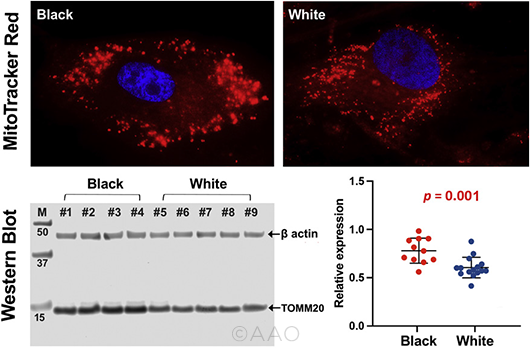Download PDF
A study of complex cellular processes associated with glaucoma risk has moved scientists closer to an understanding of why primary open-angle glaucoma (POAG) is more prevalent and severe in Black patients than in their White counterparts.1 The study focused on a marker of oxidative damage in the aqueous humor and on mitochondrial function and oxidative stress markers in trabecular meshwork cells.
“Our study identifies new findings of fundamental racial differences in trabecular meshwork cells, the main site of resistance of aqueous humor flow and intraocular pressure regulation,” said Carla J. Siegfried, MD, at Washington University School of Medicine in St. Louis, Missouri. The findings suggest the importance of oxidative stress in the pathogenic cascade of the disease and carry the promise of tailored therapeutics to block that cascade, she said.
 |
QUANTIFICATION. (Upper panel) In vitro staining of trabecular meshwork cells from study participants. (Lower left) Western blot quantification shows higher expression in Black patients than in their White counterparts. (Lower right) Levels of ROS expression (red dots = Black patients; blue dots = White patients).
|
Studying a biomarker of oxidative damage. The researchers collected aqueous humor from 173 patients (173 eyes) undergoing intraocular surgery for POAG, cataract, or both.
Patients were stratified by glaucoma severity (mild, moderate, and severe) and race. Of the 173 patients, 75 were Black, and 98 were White. Trabecular meshwork tissue from eye bank donors served as healthy controls.
The researchers looked specifically at 8-hydroxy-2’-deoxyguanosine (8-OHdG), a biomarker of oxidative damage in the aqueous humor of glaucoma patients. They found no significant racial differences in 8-OHdG measures in patients with mild or moderate disease and in controls. However, in a subgroup analysis, 8-OHdG levels were significantly higher in those Black participants who had severe glaucoma. This finding suggests that oxidative damage may be a risk factor in glaucoma pathogenesis, the researchers said.
Other events in the cascade leading to oxidative stress. The researchers also measured the quantity and activity of mitochondria in trabecular meshwork donor cells. Mitochondria are known to generate reactive oxygen species (ROS) that contribute to oxidative stress and damage, a proven mechanism of glaucoma damage.
As it turned out, ROS production was significantly higher in eyes of Black patients. This finding “suggests a fundamental biological difference in cellular metabolism, which may increase the risk of glaucoma and potentially other diseases associated with oxidative stress,” Dr. Siegfried said.
Toward prevention and treatment. The researchers plan further exploration of these cellular processes associated with glaucoma risk, particularly how they and other cellular processes change with different stages of glaucoma severity and how they relate to gene expression in trabecular meshwork cells. Currently, they are developing antioxidant therapeutics to block triggering events that lead to oxidative stress and damage.
Whether oxidative stress is a primary cause or merely a downstream consequence of glaucoma remains unclear, Dr. Siegfried said. “Our data suggest that oxidative stress is likely to be causally associated with glaucoma, especially in the Black population.”
—Miriam Karmel
___________________________
1 Wu H et al. Ophthalmology Science. 2022;2(1):doi.org/10.1016/j.xops.2021.100107.
___________________________
Relevant financial disclosures: Dr. Siegfried—None.
For full disclosures and the disclosure key, see below.
Full Financial Disclosures
Dr. Keenan NEI: E.
Dr. Seigfried NEI: S.
Dr. Margolin None.
Disclosure Category
|
Code
|
Description
|
| Consultant/Advisor |
C |
Consultant fee, paid advisory boards, or fees for attending a meeting. |
| Employee |
E |
Employed by a commercial company. |
| Speakers bureau |
L |
Lecture fees or honoraria, travel fees or reimbursements when speaking at the invitation of a commercial company. |
| Equity owner |
O |
Equity ownership/stock options in publicly or privately traded firms, excluding mutual funds. |
| Patents/Royalty |
P |
Patents and/or royalties for intellectual property. |
| Grant support |
S |
Grant support or other financial support to the investigator from all sources, including research support from government agencies (e.g., NIH), foundations, device manufacturers, and/or pharmaceutical companies. |
|
More from this month’s News in Review